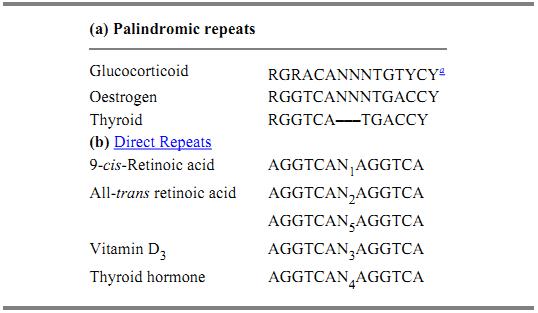


 النبات
النبات
 الحيوان
الحيوان
 الأحياء المجهرية
الأحياء المجهرية
 علم الأمراض
علم الأمراض
 التقانة الإحيائية
التقانة الإحيائية
 التقنية الحيوية المكروبية
التقنية الحيوية المكروبية
 التقنية الحياتية النانوية
التقنية الحياتية النانوية
 علم الأجنة
علم الأجنة
 الأحياء الجزيئي
الأحياء الجزيئي
 علم وظائف الأعضاء
علم وظائف الأعضاء
 الغدد
الغدد
 المضادات الحيوية
المضادات الحيوية|
Read More
Date: 13-12-2015
Date: 9-5-2021
Date: 22-12-2015
|
Hormone Response Elements
Lipophilic hormones are able to enter cells and exert their actions by binding to specific receptors . Binding of hormones of this type, such as the steroids, retinoic acid, thyroid hormone and vitamin D3, results in the activation of their receptors, which then bind to specific response elements and activate gene transcription . The detailed discussion of this process for one specific hormone and its response elements is provided in Glucocorticoid response element. This article describes the relationships between the different response elements for these various hormones (1).
In each case, the particular response element confers a specific response to a particular hormone because the response element binds only the receptor for that hormone, and not other receptors (2, 3). Thus, the glucocorticoid response element (GRE) binds the glucocorticoid receptor–glucocorticoid hormone complex and hence mediates response to glucocorticoid hormone (Table 1,
part a). However, alteration of an A residue at the third position of the palindromic GRE sequence to a T residue converts the GRE into an ERE (estrogen response element), which binds the estrogen receptor–hormone complex and therefore activates gene expression in response to estrogen (Table 1, part a). Similarly, while the glucocorticoid and estrogen response elements have a 3-bp space between the two halves of the response element, the removal of this space to make the two halves of the response element contiguous with one another results in a thyroid hormone response element )TRE) that binds the thyroid hormone receptor. Hence, relatively small changes in sequence can affect the receptor that is bound by the response element and therefore result in it mediating a different pattern of gene expression.
Table 1. Relationships Among Various Hormone Response Elements

a N indicates that any base can be present at that position, R indicates a purine ie A or G, Y indicates a pyrimidine ie. C or T. A dash indicates that no base is present, the gap having been introduced to align the sequence with the other sequences.
Although a response to thyroid hormone can be obtained by having the palindromic element illustrated in Table 1, part a, most thyroid hormone response elements are of a different form, in which the GGTCA sequence is directly repeated, with a 4-bp gap between the two direct repeats)Table 1, part b). As with the palindromic elements, the spacing between these direct repeats can affect the nature of the receptor that is bound: Direct repeats with a spacing of 1, 2, or 5 bp produce a response to different forms of retinoic acid, a 3-bp spacing produces a response to vitamin D3, and a4-bp space results in a response to thyroid hormone. Detailed structural studies of the different receptors involved have recently revealed the manner in which their different structures allow them to recognize these different response elements specifically (4).
Hence, a family of related response elements that bind a family of related receptor proteins allow different genes to respond to different, but related, lipophilic hormones.
References
1. M. Beato (1989) Cell 56, 335–344.
2. D. J. Mangelsdorf, C. Thummel, M. Beato, P. Herrlich, G. Schutz, K. Umesono, B. Blumberg, P. Castner, M. Mark, P. Shambon, and R. M. Evans (1995) Cell 83, 835–839.
3. M. G. Parker (1993) Curr. Opin. Cell Biol. 1, 512–518.
4. F. Rastinejad, T. Pearlmann, R. M. Evans, and P. B. Sigler, (1995) Nature 375, 203–211.



|
|
|
|
للعاملين في الليل.. حيلة صحية تجنبكم خطر هذا النوع من العمل
|
|
|
|
|
|
|
"ناسا" تحتفي برائد الفضاء السوفياتي يوري غاغارين
|
|
|
|
|
|
|
المجمع العلمي يقيم ورشة تطويرية ودورة قرآنية في النجف والديوانية
|
|
|